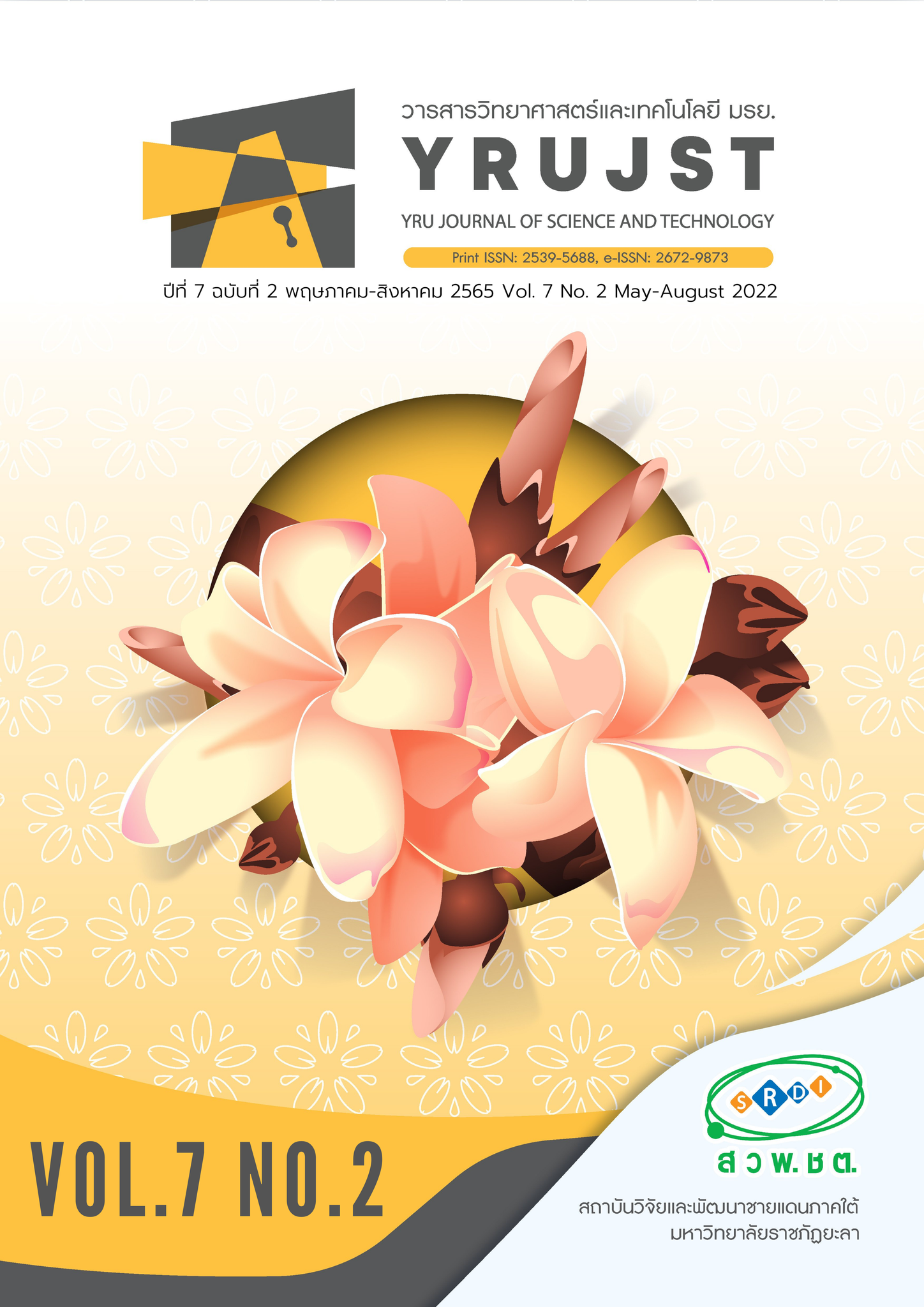The efficacy of herbal extract to control onion twister disease causal by Collectotrichum gloeosporioides fungal pathogen
Main Article Content
Abstract
The efficacy of extracts from 5 herbs was studied as follows garlic, fingerroot, galangal, turmeric and lemongrass, was studied in inhibiting Colletotrichum gloeosporioides. which is causative agent of the disease in shallot. Tested with Poison Food Technique, extracted with 95% ethanol. The culture medium containing 1,000 ppm of extracts was incubated at 25 °C for 3, 5, 7 and 9 days. Measure diameter of the fungi on the culture medium, was found that extracts of fingerroot, garlic, galangal, lemongrass, turmeric and control. Found that ability to inhibit the growth of Colletotrichum gloeosporioides were as follows: 93.86, 70.56, 24.56, 17.79, 15.79 and 0 percent, respectively. Field test to study the percentage of shallot incidence index. There were 5 test methods: M1) uninoculated, sprayed with water M2) inoculated, sprayed with water M3) inoculated, sprayed with fingerroot extract M4) inoculated with benomyl sprayed, M5) inoculated with benomyl and fingerroot sprayed, was found that M4 had a disease index of 2.17 percent. M3 had a disease incidence index of 11 percent and M5 had a disease incidence index of 7.50%. This experiment efficacy of fingerroot in controlling Colletotrichum gloeosporioides disease in shallots. Benefit to reduce use of chemicals and reduce development of fungi that affect fungal resistance.
Article Details

This work is licensed under a Creative Commons Attribution-NonCommercial-NoDerivatives 4.0 International License.
บทความ ข้อมูล เนื้อหา รูปภาพ ฯลฯ ที่ได้รับการเผยแพร่ในวารสารวิทยาศาสตร์และเทคโนโลยี มรย. นี้ ถือเป็นลิขสิทธิ์ของวารสารวิทยาศาสตร์และเทคโนโลยี มรย. หากบุคคลหรือหน่วยงานใดต้องการนำทั้งหมดหรือส่วนหนึ่งส่วนใดไปเผยแพร่ต่อหรือกระทำการใดๆ จะต้องได้รับอนุญาตเป็นลายลักษณ์อักษรจากวารสารวิทยาศาสตร์และเทคโนโลยี มรย. ก่อนเท่านั้น
References
Chaiwat, J. & Araya, J. (1999). The Fungicidal Properties of Extracts of Clove (Eugenia caryophyllus Spreng.) and Sweet Flag (Acorus calamus Linn.). Acta Hortic, 501, 87-94.
Elaissi, A., Rouis, Z., Salem, N.A., Mabrouk, S., Bensalem, Y. & Salah, K.B. (2012). Chemical composition of 8 eucalyptus species essential oils and the evaluation of their antibacterial, antifungal and antiviral activities. BMC Complementary Alternative Medicine, DOI: 10.1186/1472-6882-12-81.
Euis, N., Rizal, S., Zainal, A., Sobir, S. & Machfud, M. (2020). Analysis of mancozeb and carbofuran pesticides residues in the production area of shallot (Allium cepa L. var. ascalonicum) Bulgarian. Journal of Agricultural Science, 26(5), 974-981.
Jae, W.H., Sang, H.S., Kyoung S.J., Yong, H.C., Quang, L.D., Hun, K. & Gyung, J.C. (2018). In vivo assessment of plant extracts for control of plant diseases: A sesquiterpene ketolactone isolated from Curcuma zedoaria suppresses wheat leaf rust. Journal of Environmental Science and Health, 53(2), 135-140.
Jin, Z., Xiaoyu, D., Yechun, X., Yongqiang, D., Meiqin, L. & Yao, Z. (2020). Structure of Mpro from SARS-CoV-2 and discovery of its inhibitors. Nature, 528, 289-293.
Jyoti, S., Bhatnagar, S.K. & Akash T. (2019). Study on fungicidal effect of plant extracts on plant pathogenic fungi and the economy of extract preparation and efficacy in comparison to synthetic/chemical fungicides. Journal of Applied and Natural Science, 11(2), 333-337.
Khan, S.A., Zia, K., Ashraf, S., Uddin, R. & Ul-Haq, Z. (2020). Identifcation of chymotrypsin-like protease inhibitors of SARSCoV-2 via integrated computational approach. Journal of Biomolecular Structure and Dynamics, 39(7), 2607-2616.
Kittika, J., Amnart, P., Kanjana, I., Saranya, P., Phanwimol, T. & Susumu, K. (2017). Inhibitory Effects of Thai Essential Oils on Potentially Aflatoxigenic Aspergillus parasiticus and Aspergillus flavus. Biocontrol Science, 22(1), 31-40.
Manasi, K.B. & Ajit G.D. (2014). Antifungal activity of herbal extracts against plant pathogenic fungi. Archives of Phytopathology and Plant Protection, 47(8), 959-965.
Mani, J.S., Janice, S., Mani, J.B., Johnson, J.C., Steel, D.A., Broszczak, P.M., Neilsen, K.B. & Walsh, M.N. (2020). Natural product-derived phytochemicals as potential agents against coronaviruses. Virus Research, 284, 1-16.
Meenakshi, S. & Saurabh, K. (2015). Colletotrichum gloeosporioides: An Anthracnose Causing Pathogen of Fruits and Vegetables. Biosciences Biotechnology Research ASIA, 12(2), 1,233-1,246.
Miyara, C., Shnaiderman, X., Meng, X., Vargas, W.A., Diaz-Minguez, J.M. & Sherman, A. (2012). Role of Nitrogen Metabolism Genes Expressed During Pathogenicity of the Alkalinizing Colletotrichum gloeosporioides and Their Differential Expression in Acidifying Pathogens. The American Phytopathological Society, 25(9), 51-63.
Nuchnualrat, P.& Boonroj, A. (2008). Effect of Prochloraz, Benomyl, Carbendazim, Azoxystrobin, Mancozeb and Copper oxychloride for Controlling Anthracnose Disease of Dragon Fruit. Rajabhat Rambhai Barni Research Journal, 9(2),15-20.
Nuchnualrat, P.& Jitsartta, N. (2022). Evaluation of fungicide carbendazim resistance in Colletotrichum gloeosporioides causing anthracnose disease of mango cv. Aokrong in Chanthaburi province. RMUTSB Academic Journal, 9(2), 164-173
Oranun, O. & Wannee, J. (2017). Fingerroot, Boesenbergia rotunda and its Aphrodisiac Activity. Pharmacogn Rev., 11(21), 27-30.
Phukang, J. & Chaisuk, P. (2016). Effects of some Fungicides on Growth Inhibition of Colletotrichum gloeosporioides, Causal Agent of Onion Twister Disease. Jourual of Agriculture, 32(2), 181-189. (in Thai).
Rattanakreetakul, C. (2013). Fumigation with Plant Volatile Oils to Control Stem End Rot of Banana. Acta Hortic, 973, 207-213


